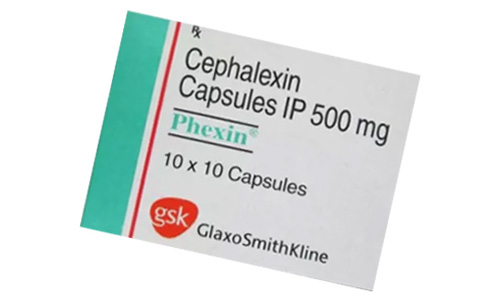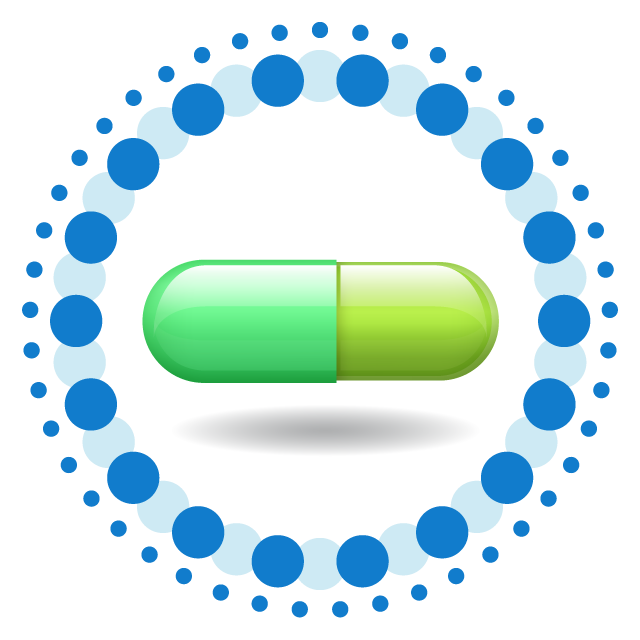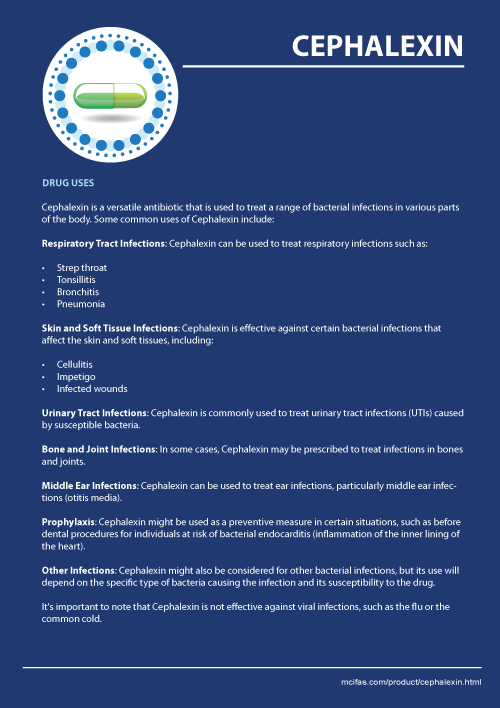Cephalexin Prescribing Information
Cephalexin is an antibiotic medication that belongs to the class of drugs known as cephalosporins. It is commonly used to treat a variety of bacterial infections in different parts of the body. Antibiotic works by interfering with the bacteria's cell wall formation, leading to their eventual death.

Uses of Cephalexin
Cephalexin is a versatile antibiotic that is used to treat a range of bacterial infections in various parts of the body. Some common uses include:
Respiratory Tract Infections: Medicine can be used to treat respiratory infections such as:
- Strep throat
- Tonsillitis
- Bronchitis
- Pneumonia
Skin and Soft Tissue Infections: Antibiotic is effective against certain bacterial infections that affect the skin and soft tissues, including:
- Cellulitis
- Impetigo
- Infected wounds
Urinary Tract Infections: Cephalexin is commonly used to treat urinary tract infections (UTIs) caused by susceptible bacteria.
Bone and Joint Infections: In some cases, Cephalexin may be prescribed to treat infections in bones and joints.
Middle Ear Infections: Drug can be used to treat ear infections, particularly middle ear infections (otitis media).
Prophylaxis: Cephalexin might be used as a preventive measure in certain situations, such as before dental procedures for individuals at risk of bacterial endocarditis (inflammation of the inner lining of the heart).
Other Infections: Antibiotic might also be considered for other bacterial infections, but its use will depend on the specific type of bacteria causing the infection and its susceptibility to the drug.
It's important to note that Cephalexin is not effective against viral infections, such as the flu or the common cold.
Dosage
The dosage of Cephalexin can vary depending on the type of infection being treated, the patient's age and weight, and other individual factors. It's crucial to follow the dosing information on the prescription label. The following dosages are general guidelines and may not be appropriate for everyone. Always consult your doctor for personalized dosing recommendations.
Here are typical dosages for this drug:
Adults:
- For most infections: The typical adult dose is 250 mg to 500 mg every 6 hours, or 500 mg to 1,000 mg every 12 hours.
- For severe infections or those caused by more resistant bacteria: The dosage might be increased.
Children:
Dosage is usually based on the child's weight. The typical dosages range from 25 mg/kg per day to 50 mg/kg per day, divided into multiple doses.
Urinary Tract Infections:
- Adults: 250 mg to 500 mg every 6 hours.
- Children: Dosage varies based on weight, typically ranging from 25 mg/kg per day to 50 mg/kg per day.
Strep Throat and Tonsillitis:
- Adults and children: The typical dosage is 500 mg every 12 hours or 250 mg every 6 hours, for a total of 10 days.
Skin and Soft Tissue Infections:
- Dosage can vary based on the severity of the infection. A typical dosage might be 250 mg to 500 mg every 6 hours.
It's important to take Cephalexin with a full glass of water and to follow the prescribed schedule consistently.
If you miss a dose, take it as soon as you remember. If it's close to the time for your next dose, skip the missed dose and continue with your regular schedule. Never take double doses to make up for a missed one.
Side Effects of Cephalexin
Cephalexin can potentially cause side effects. Not everyone will experience these side effects, and their severity can vary. Common side effects might include:
Gastrointestinal Issues:
- Nausea
- Vomiting
- Diarrhea
- Abdominal pain or discomfort
Allergic Reactions:
- Rash or hives
- Itching
- Swelling of the face, lips, or tongue
- Difficulty breathing
Yeast Infections:
- Cephalexin use can sometimes lead to overgrowth of yeast (Candida) in certain areas, resulting in oral or genital yeast infections.
Other Skin Reactions:
- Skin redness
- Skin rash
- Peeling or blistering of the skin
Changes in Mouth and Taste:
- Changes in taste perception
- Mouth sores or ulcers
Hematologic Effects:
- Rarely, Cephalexin might affect blood cell counts, causing conditions like anemia or low platelet count.
Kidney Effects:
- In some cases, Cephalexin can cause changes in kidney function, which might be monitored through blood tests.
Central Nervous System Effects:
- Headache
- Dizziness
Joint Pain:
- Some individuals may experience joint pain while taking Cephalexin.
It's important to note that severe side effects are relatively rare, but if you experience any unusual or severe symptoms while taking Cephalexin, you should contact a healthcare professional immediately. If you have a history of allergies, especially to antibiotics or other medications.
In rare cases, Cephalexin can cause a severe allergic reaction called anaphylaxis, which is a medical emergency. Signs of anaphylaxis include difficulty breathing, swelling of the face or throat, and a rapid or irregular heartbeat. Seek immediate medical attention if you experience these symptoms.
Interaction with other drugs
Cephalexin can interact with other drugs, potentially affecting their effectiveness or increasing the risk of side effects. Here are some notable interactions to be aware of:
- Probenecid: Probenecid can slow down the elimination of Cephalexin from the body, potentially leading to higher levels of this medicine in the bloodstream. This interaction might require adjusting the dosage of antibiotic.
- Drugs that Affect the Kidneys: Pharmaceutical product is primarily eliminated through the kidneys. Drugs that affect kidney function, such as diuretics or certain blood pressure medications, can influence the levels of this medicament in the body.
- Oral Contraceptives: There have been reports of Cephalexin reducing the effectiveness of oral contraceptives (birth control pills). It's recommended to use additional methods of contraception while taking this drug.
- Warfarin and Anticoagulants: Cephalexin might increase the effects of anticoagulant medications like warfarin, potentially increasing the risk of bleeding.
- Methotrexate: Medicament might decrease the elimination of methotrexate from the body, leading to increased levels of methotrexate and a higher risk of its side effects.
- Medications that Decrease Stomach Acid: Drugs that reduce stomach acid (proton pump inhibitors, H2 blockers) might affect the absorption of Cephalexin. It's generally recommended to take capsules with a full glass of water on an empty stomach.
- Live Bacterial Vaccines: Remedy might reduce the effectiveness of live bacterial vaccines. Consult your doctor about the appropriate timing of vaccinations if you're taking capsules.
- Medications for Gout: Antibiotic might interact with medications used to treat gout, such as probenecid or sulfinpyrazone.
What to avoid while on Cephalexin
While taking Cephalexin, there are certain things you should be cautious about or avoid to ensure the medication's effectiveness and your overall health. Here are some important points to consider:
- Alcohol: It's generally recommended to avoid alcohol while taking antibiotics. Alcohol can interfere with the effectiveness of the antibiotic and might also increase the risk of side effects.
- Antacids and Acid-Reducing Medications: Antacids that contain aluminum or magnesium, as well as medications that reduce stomach acid (proton pump inhibitors and H2 blockers), can potentially affect the absorption of Cephalexin. If you need to take antacids or acid-reducing medications, try to space them apart from your doses.
- Oral Contraceptives: Cephalexin might reduce the effectiveness of oral contraceptives (birth control pills). If you are taking oral contraceptives, it's advisable to use an additional form of contraception while on antibiotic and for a short time afterward.
- Other Medications: Some medications can interact with Cephalexin, potentially affecting its efficacy or increasing the risk of side effects.
- Dairy Products: Some people believe that consuming dairy products can reduce the effectiveness of antibiotics. While there is limited scientific evidence to support this, it might be a good idea to space out dairy consumption from your Cephalexin doses, just to be cautious.
- Sun Exposure: Cephalexin itself doesn't necessarily increase sun sensitivity, but some people might experience heightened sensitivity to the sun when taking antibiotics. If you notice any increased sensitivity, take precautions like using sunscreen and protective clothing.
- Driving and Operating Machinery: Some individuals might experience dizziness or drowsiness as a side effect. If you experience these effects, avoid activities that require alertness, such as driving or operating heavy machinery.
- Allergens: If you are allergic to antibiotics in the same class (cephalosporins), it's important to avoid them.
Contraindications of Cephalexin
Cephalexin has certain contraindications, which are specific situations or conditions where the use of the medication is not recommended due to potential risks. Here are some contraindications:
- Allergy to Cephalosporins or Penicillins: If you have a known allergy to Cephalexin, other cephalosporins, or penicillins, you should not take capsules, as there is a higher risk of an allergic reaction.
- Severe Kidney Impairment: Individuals with severely impaired kidney function might need to have their Cephalexin dosage adjusted or might not be suitable candidates for the medication due to the risk of accumulation in the body.
- Colitis or Gastrointestinal Issues: Drug can sometimes lead to a condition called pseudomembranous colitis, which is a severe inflammation of the colon. If you have a history of gastrointestinal issues, especially colitis, the use of Cephalexin might be contraindicated.
- Porphyria: Porphyria is a group of rare genetic disorders that affect the nervous system or skin. Cephalexin might exacerbate symptoms in individuals with porphyria.
- Biliary Tract Obstruction: Remedy is excreted primarily through the bile. If you have a biliary tract obstruction, the use of Cephalexin might be contraindicated due to potential issues with elimination.
- History of Seizures: Although rare, some individuals might experience seizures as a side effect.
- Serious Hypersensitivity Reactions: If you have experienced severe hypersensitivity reactions to Cephalexin in the past, its use might be contraindicated.
Pregnancy and Cephalexin
Cephalexin is generally considered safe to use during pregnancy, but it's important to use it under the guidance of a healthcare provider. The safety of any medication during pregnancy depends on various factors, including the trimester of pregnancy, the specific medication, the dosage, and the potential benefits versus risks.
Here are some considerations regarding the use of Cephalexin during pregnancy:
- Category B: Medicament is classified as a Category B medication by the U.S. Food and Drug Administration (FDA) for pregnancy. This means that animal studies have not shown a risk to the fetus, and there are limited or no studies in pregnant women. However, the medication should be used only if the benefits to the mother outweigh any potential risks to the fetus.
- Urinary Tract Infections: This pharmaceutical product is commonly prescribed to treat urinary tract infections during pregnancy. Untreated urinary tract infections can lead to more serious complications, so treating them with antibiotics can be important.
- Dosage and Duration: Doctors will often prescribe the lowest effective dose of Cephalexin for the shortest duration necessary to treat the infection. This helps minimize any potential risks.
- Risk of Allergic Reactions: As with any medication, there is a small risk of allergic reactions. Pregnant women who are known to be allergic to Cephalexin or other antibiotics should avoid taking them.
- Breastfeeding: Cephalexin is generally considered safe to use while breastfeeding. It is unlikely to harm the nursing infant, but as with pregnancy, it's important to consult your doctor before using any medication while breastfeeding.
» Drug Uses (format pdf, 0.2 Mb)



